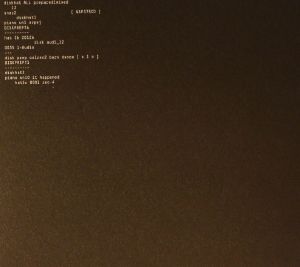Filter
在庫状況
Type
フォーマット
アーティスト
レーベル
Featured
リリースタイトル
値段
タグ
Back catalogue: All genres
Juno's full catalogue of All genres
シングル
in stock $11.61
Played by: Kelpe
in stock $11.89
アルバム
Selected Ambient Works Volume II (Expanded Edition) (3xCD in hard-back book sleeve)
Cat: WARPCD 21R. Rel: 03 Oct 24
Ambient/Drone
Review: The Expanded Edition of Aphex Twin's Selected Ambient Works Volume II is here; this is a reissue of an album that still serves as one of the ideasthetic backbones to most music fans' idea of 'ambient music' at large. A lesser-known fact is that when James recorded the record, he had concurrently undergone a period of lucid dreaming, and in this vivid lucid state, had heard many sounds akin to those heard on this record, which he had subsequently attempted to recreate. The sound of dreaming is usually an ineffable thing, but not to Aphex Twin, who had perhaps been one of the first to articulate dreams' bleary, smeary, selective and dream-distorted sonic quality. Many different interpreters have harped on this record, some hearing a 'cold islationism' in it, others a purer bliss; what is most evident is this one helped popularise ambient music in a formal, less connotative way, and continues to do so even today. This expanded versions features two unreleased tracks - that is, if you don't include the famous Soundcloud dump of nine years ago, plus 'Blue Calyx' now features on all formats instead of vinyl only.
… Read more in stock $24.32
Review: Some 25 years after delivering his debut 12", Richard D James hasn't lost the ability to thrill or inspire. By his obtuse standards, the material that makes up the surprise Cheetah EP is actually rather laidback and melodious. "Cheetah2 (LD Spectrum)", for example, sounds like a slow house jam written by robots, while the even deeper "Cheetah7B" shuffles along in a metronomic fashion, seemingly oblivious to the increasingly aggressive World at large. Of course, those trademark skittish IDM rhythms are present and the Cornishman has thrown in a couple of hazy ambient cuts for good measure.
… Read morePlayed by: Lo Shea
in stock $11.33
Cat: WAP 375CD. Rel: 23 Jan 15
Experimental/Electronic
in stock $14.10
Review: By 1996, Richard D. James, aka Aphex Twin, had a prolific career at 26. He co-ran Rephlex Records, signed with Warp Records, and had multiple releases and MTV-aired music videos. His fame surged with the 1997 Come to Daddy EP and Chris Cunningham-directed music videos. James was constantly creating music, describing his output as endless. The Richard D. James Album marked a turning point, featuring his creepy distorted smile on the cover, solidifying his bizarre persona. Despite his unassuming demeanor, James's music was wildly innovative. Raised in Cornwall, he preferred making music in solitude, viewing himself as "some kid mucking around in his bedroom." Departing from previous methods, the album was entirely computer-made, reflecting recent work. James aimed for accessibility with hidden complexity, making the music engaging yet intricate. The album featured more structured songs with clear melodies, such as 'Girl/Boy Song,' blending orchestral sounds with drum solos. Symphonic elements persisted, creating emotionally resonant moments. Tracks like '4' and 'Fingerbib' showcased his ambient sensibilities and inventive sounds. Vocals, heavily altered, added a unique touch.
The album combined delicate symphonics with intense beats, exploring drill ‘n’ bass. It had a cohesive vision, evident in tracks like 'Cornish Acid' and 'Peek 82454201.' Named after his deceased brother, the album held personal significance, subtly influencing its depth and emotion.
… Read moreThe album combined delicate symphonics with intense beats, exploring drill ‘n’ bass. It had a cohesive vision, evident in tracks like 'Cornish Acid' and 'Peek 82454201.' Named after his deceased brother, the album held personal significance, subtly influencing its depth and emotion.
Played by: Juno Recommends Experimental
in stock $14.37

 USD
USD












